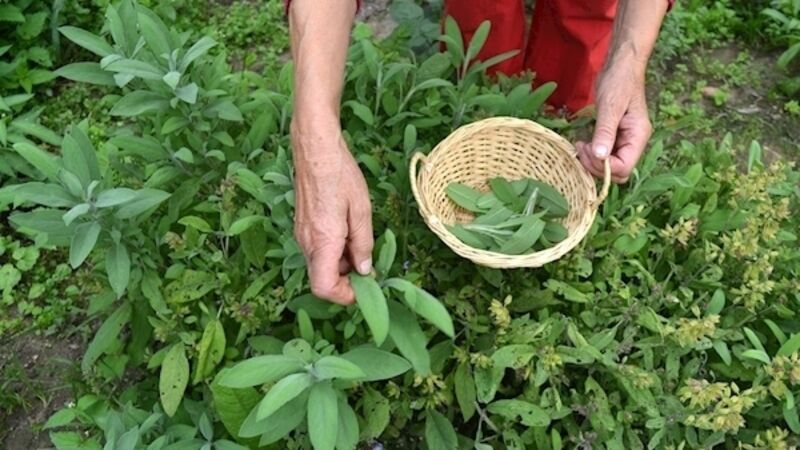Get wise about growing sage

is a fan of this hardy perennial that has a variety of both culinary and medicinal uses.
SAGE (Salvia officinalis) is a sub-shrubby, evergreen perennial of the labiate family, with aromatic silvery-green leaves and racemes of lilac-blue flowers in early summer.
There are many cultivars as well as purple leaf forms and variegated varieties. It has both culinary and medicinal uses. It is a nectar plant for bees and many pollinators and a delight in the border, containers or herb garden. Pretty hardy and pretty much drought-tolerant. I love it.
In culinary terms, sage is strongly aromatic and slightly on the bitter side. Dried sage is more pungent than fresh. Both dry and fresh can withstand long cooking times without losing any aroma or flavour.
It’s a popular addition to casseroles, soups and stews and in stuffing mixtures. I grow a pineapple sage that is brilliant mixed with lentils or tomatoes in stuffed peppers. Normal sage – as it were – is beautiful with pasta and potato dishes as well as all the standard meat fare.
In medicinal terms, the clue is often in the name; Salvia having roots in the Latin salvere, “to save”, denoting its manifold medicinal applications, and ‘‘officinalis’’ further reminding us of its official curative status. Sage is one of the oldest medicinals. It has been utilised in fumigation and smudging rituals from the earliest of times, on several continents.
Reputed to inspire and gift wisdom and spiritual awareness, this is an herb that is said to “reveal the path” and lift the cloud of indecisiveness.
There is certainly wisdom in cooking with it or making medicinal teas to benefit from its antioxidant compounds to keep the brain clear and the lungs open.
Common sage is probably best known for menstruation and menopausal complaints. Sage has estrogenic and emmenagogue (period-stimulating) actions. Its anti-inflammatory and antispasmodic constituents such as rosmarinic acid help relieve stomach cramp and mild back pain.
Rosmarinic acid is also said to help reduce anxiety and nervous tension while sage’s content of linalool has sedative properties.
A simple brew of sage tea contains phytosterols that exert a cooling action upon the body and being an antihidrotic herb it further helps to reduce or prevent sweating. Its astringent action is also availed of to stop lactation post-weaning.
Phytosterols also inhibit cholesterol absorption. The culinary usage of sage is generally matched to fatty foods to help improve their digestion and metabolism by increasing the efficiency and production of digestive enzymes.
It is antimicrobial and antispasmodic and so is said to help ease digestive disorders.
The tea or a soup can be utilised as a bitter tonic and to exert a beneficial effect on the liver. Sage also has traditional herbalism uses in the treatment of depression, loss of appetite, post-viral fatigue, nervous exhaustion and general debility, indigestion, to strengthen the lungs, address circulatory issues including diabetic neuropathy, promote memory and strengthen the brain.
Externally, cooled sage tea can be used as an antibacterial mouthwash and as a gargle for treating a sore throat and tonsillitis.
A bit of a wonder herb. I would just add that it may be best to avoid in pregnancy and when breastfeeding (due to oestrogens) and to steer clear of if you are allergic to aspirin as it contains salicylates.
How to cultivate
Sage is a slow starter from seed and can take its time too as a cutting but once up and established it will do well.
Easily maintained if placed right from the start, it prefers slightly alkaline soil. It does best in a sunny location with light, free-draining or grit-amended soil – the trick is to mimic the Mediterranean where it originated from.
You could wait until April and sow seeds in situ about 30cm apart – a cloche will be invaluable – but now is the perfect time to sow seed indoors to get a good march on planting out in a few months’ time.
If you have a propagator they will germinate in the range of 15-20C, but that’s close enough achieved on a windowsill in a seed tray with a clear plastic covering (clingfilm or bought lid).
With a professional propagator, it may take 21 days for first shoots to arrive, on a window ledge it may be closer to 30.
I like to surface sow onto an already moistened (but well drained-off) seed-mix compost or sterilised garden soil (exposing it to a kettle of boiling water does that trick). Then dust the top with a light sprinkling of more compost or sand, until the seeds are roughly 1cm deep.
Cover and wait. Once true leaves emerge you can transplant seedlings to individual small pots, to harden off. Plant out at 45-60cm spacing.
Aftercare
Once in free-drained soil and full sun, your sage plants will have relatively few problems.
It is advised for culinary crops of sage that you should renew your plants every three to four years. This does not have to be an expense as new plants can easily be propagated from cuttings.
That said, if you use a lot from what you grow, the natural pruning that occurs should keep the plant in relative juvenile vigour and you may get longer before it begins to grow woody and less aromatic.












